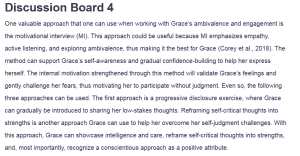Discussion Board 4
One valuable approach that one can use when working with Grace’s ambivalence and engagement is the motivational interview (MI). This approach could be useful because MI emphasizes empathy, active listening, and exploring ambivalence, thus making it the best for Grace (Corey et al., 2018). The method can support Grace’s self-awareness and gradual confidence-building to help her express herself. The internal motivation strengthened through this method will validate Grace’s feelings and gently challenge her fears, thus motivating her to participate without judgment. Even so, the following three approaches can be used. The first approach is a progressive disclosure exercise, where Grace can gradually be introduced to sharing her low-stakes thoughts. Reframing self-critical thoughts into strengths is another approach Grace can use to help her overcome her self-judgment challenges. With this approach, Grace can showcase intelligence and care, reframe self-critical thoughts into strengths, and, most importantly, recognize a conscientious approach as a positive attribute.
Another strategy a professional can utilize is to introduce structured activities that allow Grace to share small, low-stakes thoughts gradually. This approach is called the progressive disclosure exercise. In this regard, the best illustration to show how this works is asking Grace to share one-word answers or brief responses on lighter topics before discussing more personal fears. As a result, the gradual exposure can help her become comfortable speaking without rehearsing while building trust with group members. When these strategies are used collectively, Grace can shift from her perspective and gradually cut down on her self-criticism and instead build on self-trust and the group, promoting a more open and relaxed participation.
References
Corey, M. S., Corey, G. & Corey, C. (2018). Groups: Process and practice. Thomson/Brooks/Cole.
ORDER A PLAGIARISM-FREE PAPER HERE
We’ll write everything from scratch
Question
Textbook:
DB 4: In Chapter 8 the book discusses a client by the name of Grace. During the working stages of the group what theory do you think you would utilize to maintain and/or increase Grace’s ambivalence and engagement in the group. What are three strategies (DO NOT UTILIZE A STRATEGY IDENTIFIED WITHIN THE BOOK) you might use when working with Grace?

Discussion Board 4
Please Note: posts should be written in APA formatting, citing sources, and a minimum of 275.

